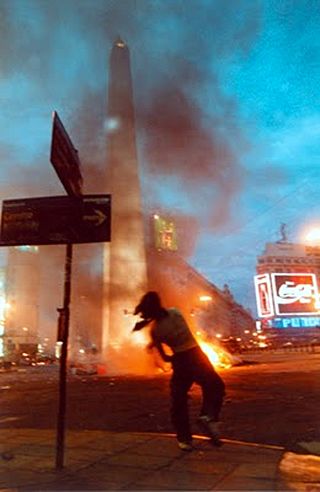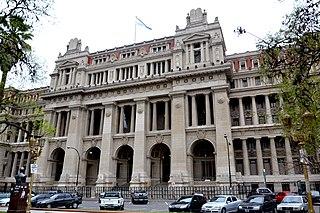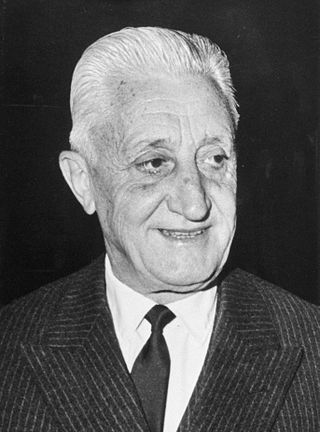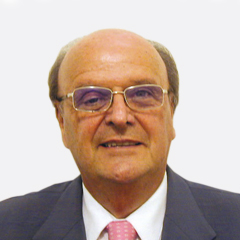The United States Presidential Succession Act is a federal statute establishing the presidential line of succession. Article II, Section 1, Clause 6 of the United States Constitution authorizes Congress to enact such a statute:
Congress may by Law provide for the Case of Removal, Death, Resignation or Inability, both of the President and Vice President, declaring what Officer shall then act as President, and such Officer shall act accordingly, until the Disability be removed, or a President shall be elected.

The United States presidential line of succession is the order in which the vice president of the United States and other officers of the United States federal government assume the powers and duties of the U.S. presidency upon an elected president's death, resignation, removal from office, or incapacity.

Eduardo Alberto Duhalde is an Argentine former peronist politician who served as the interim President of Argentina from January 2002 to May 2003. He also served as Vice President and Governor of Buenos Aires in the 1990s.

The president of Argentina is both head of state and head of government of Argentina. Under the national constitution, the president is also the chief executive of the federal government and commander-in-chief of the armed forces.

Adolfo Rodríguez Saá is an Argentine Peronist politician. Born in a family that was highly influential in the history of the San Luis Province, he became the province's governor in 1983, after the end of the National Reorganization Process military dictatorship. He remained governor up to 2001, being re-elected in successive elections.

José María Guido Cibeira was President of Argentina from 29 March 1962 to 12 October 1963, serving as the head of a provisional civilian government after the Argentine military overthrew President Arturo Frondizi. Guido's nineteen months in office were characterized by a severe economic recession, open conflict between competing factions within the armed forces, and anti-democratic measures including continued proscription of Peronists from Argentine politics. Yet Guido, with critical support from the "legalist" faction of the military, prevailed in his mission to return Argentina to constitutional government with a general election held on 7 July 1963.

The December 2001 crisis, sometimes known as the Argentinazo, was a period of civil unrest and rioting in Argentina, which took place during December 2001, with the most violent incidents taking place on 19 and 20 December in the capital, Buenos Aires, Rosario and other large cities around the country. It was preceded by a popular revolt against the Argentine government, rallying behind the motto "All of them must go!", which caused the resignation of then-president Fernando de la Rúa, giving way to a period of political instability during which five government officials performed the duties of the Argentine presidency. This period of instability occurred during the larger period of crisis known as the Argentine great depression, an economic, political, and social crisis that lasted from 1998 until 2002.

The Supreme Court of Argentina, officially known as the Supreme Court of Justice of the Argentine Nation, is the highest court of law of the Argentine Republic. It was inaugurated on 15 January 1863. However, during much of the 20th century, the Court and the Argentine judicial system in general, lacked autonomy from the executive power. The Court was reformed in 2003 by the decree 222/03.

Aníbal Domingo Fernández is an Argentine Justicialist Party politician, lawyer, and certified public accountant. Throughout his career, he has remained a close ally to the former Presidents Néstor Kirchner and Cristina Fernández de Kirchner. Between 2021 and 2023, he served as Argentina's Minister of Security in the cabinet of President Alberto Fernández.

Isaac Francisco Rojas Madariaga was an Argentine Admiral of the Navy and de facto Vice President of Argentina. He joined the Argentine Navy and had an unremarkable career until the 1946 election of Juan Perón.
The order of precedence in Argentina is a symbolic hierarchy of officials used to direct protocol. It is regulated by Presidential Decree 2072 of 10 October 1993, signed by then President Carlos Menem, and former ministers Guido di Tella and Carlos Ruckauf.

The Argentine general election of 1963 was held on 7 July. Voters chose both the President and their legislators; with a turnout of 85.6%, resulting in the election of Arturo Illia as President of Argentina.
In Argentina, there were six coups d'état during the 20th century: in 1930, 1943, 1955, 1962, 1966 and 1976. The first four established interim dictatorships, while the last two established dictatorships of permanent type on the model of a bureaucratic-authoritarian state. The latter conducted a Dirty War in the line of State terrorism, in which human rights were systematically violated and there were tens of thousands of forced disappearances.
The de facto government doctrine is an element of Argentine case law related to the validity of the actions of de facto governments. It allowed the government actions taken during those times to stay valid after the de facto government had ended. It was initially ruled by the Supreme Court in 1930, and stayed active as law until the 1994 amendment of the Argentine Constitution.

Federal Peronism, also known as Dissident Peronism, is the faction or branch of either moderate, centrist or right-wing Peronism, that is currently identified mostly by its opposition to Kirchnerism, the left-wing faction of Peronism.

Alejandro Gómez was an Argentine educator and lawyer who served as the Vice President of Argentina.

José Ignacio "Vasco" de Mendiguren is an Argentine industrialist and politician. He was chairman of the Argentine Industrial Union, director of the National Bank of Argentina, and Minister of Production during the presidency of Eduardo Duhalde. From 2013 to 2021, he was a National Deputy elected in Buenos Aires Province, as part of the Renewal Front and later as part of the Frente de Todos.

Graciela María Giannettasio de Saiegh was an Argentine politician belonging to the Justicialist Party. She served in a number of high-profile posts during her career, most notably as Minister of Education during the interim presidency of Eduardo Duhalde from 2002 to 2003, and later as Vice Governor of Buenos Aires Province under Felipe Solá from 2003 to 2007.


















